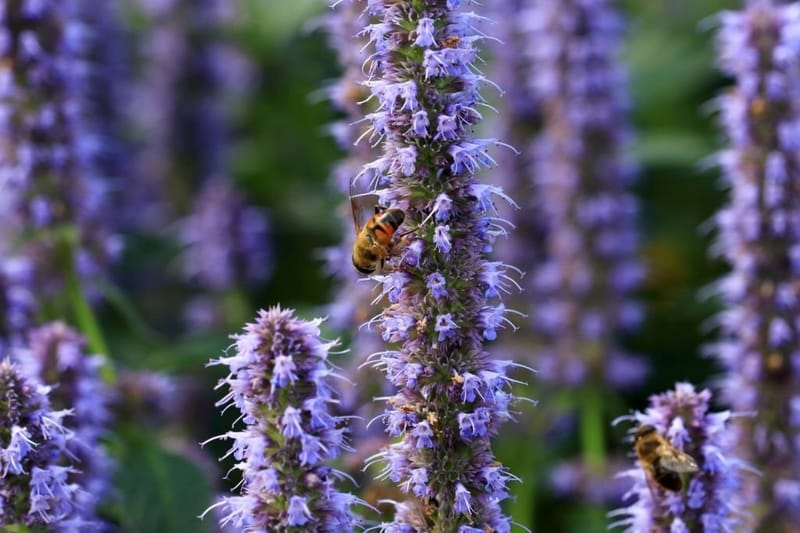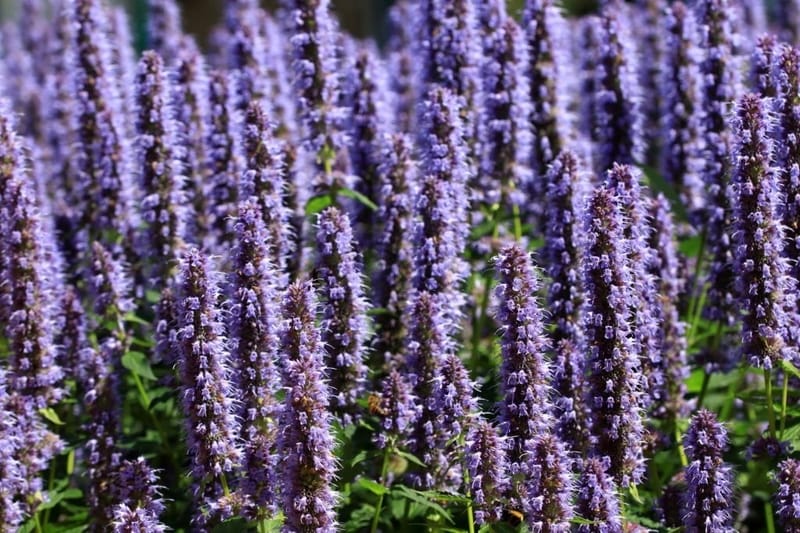Salvia Marcus (Salvia Nemorosa) is a short-growing perennial that can be used as a ground cover, edging or in containers. It is a dwarf strain of commonly known as the May Night Salvia. Salvia Marcus has purple-blue flowers that bloom throughout the summer months and attract hummingbirds and butterflies.
This plant belongs to the family of Lamiaceae and its genus is Salvia. This perennial herb grows up to around 1 feet in height with an equal spread. Its green leaves are thin and ovate with serrated edges while the stems are square-shaped with hairs growing along them while they are young but become smooth as they age.
Growing Salvia Marcus
Sunlight
Salvia Marcus is a beautiful, aromatic plant that’s easy to grow and thrives in full sun. Salvia Marcus is a great choice for your garden if you’re looking for something that won’t need much attention, since it grows best in full sun.
Soil Needs and pH.
Salvia Marcus is a beautiful plant. It can grow in any type of soil, but it prefers to be planted in a sandy, well-drained soil.
The pH of the soil should be between 5.5 and 7.5 for optimal growth. The soil should be light and fluffy, but not so much that water cannot drain through it easily. Salvia Marcus does not like wet feet, so make sure that you give your plants enough drainage to prevent excess moisture from building up in the soil around their roots.
Water Needs
Watering frequency
Salvia Marcus is a drought-resistant plant. While it doesn’t need to be watered often, it does require a little bit of care.
Water your Salvia Marcus whenever the soil feels dry to touch, but don’t over water it! After watering your plant thoroughly, wait until the soil has completely dried out before watering again. If you notice any signs of wilting or yellowing leaves, it means your plant needs more water than usual so give each leaf a quick mist with a spray bottle every day until things look better.
Temperature
The Salvia Marcus is a perennial shrub that flourishes in hot, dry climates. Its optimal temperature range is between 65°F and 90°F, with the best results being seen when it is between 75°F and 85°F.
It is hardy in zones 4-9 and can tolerate temperatures as low as -10 degrees Fahrenheit.
Best Propagation Methods
Propagate by cuttings
Cut the stems of your plant at a 45 degree angle and place them in water until they root.
Propagate by seed
With a sharp, sterile knife, remove the seeds from their pods and place them on top of damp paper towel in a plastic container or baggie with holes poked in it to allow for air circulation. Place this container where it will receive indirect sunlight and keep warm (about 70-75 F). Allow about three weeks for germination, once sprouted, move seedlings into individual pots with an organic potting mix that drains well and then transplant outside once temperatures are above 60 degrees Fahrenheit (16 C).
Propagate by division
Divide clumps every two years or so to encourage new growth; dig up clumps with a shovel and divide into smaller sections using a sharp knife. Replant each piece in its own pot filled with slightly acidic soil mixed with compost or peat moss; repot after division has taken place but before new growth begins to appear on any of the pieces so as not to disturb roots too much when replanting them back into larger containers again later down the line!
When to plant Salvia Marcus?
Salvia Marcus can be grown in the spring, summer, and fall. It prefers full sun and sandy soil, so make sure to plant it in an area that receives at least six hours of sunlight per day.
Salvia Marcus can be planted directly into the ground or in pots. To plant in pots, fill each pot with potting soil and place the plant’s root ball in the center of the pot. Make sure you don’t pack down the soil around it too tightly; leave enough space for water to drain at the bottom of the pot. Water your plants well after planting them in pots but don’t overwater them!
The best time to start growing Salvia Marcus is at least one month before your average last frost date (the date when temperatures drop below freezing). If you live in an area where there are no hard frosts and winter comes quickly, then you should start growing your Salvia Marcus during late summer or early autumn so that it has time to mature before winter arrives.Best Seasons.
The best time to plant Salvia Marcus is in the spring or fall. Planting during the hot summer months can be difficult and may result in poor growth. Similarly, planting in cold weather should also be avoided.
How to Plant Salvia Marcus in the Garden?
Planting Salvia Marcus in a garden is as simple as planting any other plant. The only thing you need to do differently is ensure that the plant has enough room to grow, especially during the first year.
Plant Salvia Marcus at least 12 inches apart from one another, but not more than 24 inches apart.
Make sure the soil is moist before planting your plants so they don’t dry out quickly after being planted.
You can either plant them in ground or in containers such as pots or saucers with drip trays underneath them. If you choose to use a pot, it should be at least 8″ wide and deep enough so that there’s still at least 6″ of space between the surface level of soil and top edge of your container.
How to Grow Salvia Marcus indoors as a Houseplant?
To grow Salvia Marcus indoors, you will need a pot that at least 8″ in diameter.
I like to use a combination of peat moss and perlite for my indoor plants because it holds some moisture but still allows them to dry out between waterings. You may also want to consider using an organic fertilizer such as fish emulsion once or twice a month during the growing season (March through August).
Best Temperature for growing Salvia Marcus.
The best temperature for growing Salvia Marcus is a warm, sunny spot. Salvia Marcus can tolerate temperatures as low as 15 degrees Fahrenheit (10 Celsius), but it does not tolerate frost. The plant grows best in locations that have an average high temperature of 70 degrees Fahrenheit (21 Celsius) and an average nighttime low of 60 degrees Fahrenheit (16 Celsius).
Uses of Salvia Marcus
Salvia Marcus can be used to fill in gaps and borders, and it makes a great border plant. It also works well as an ornamental plant, so it can be planted along pathways or by itself. Salvia Marcus is great for attracting bees, butterflies and hummingbirds which will help pollinate other plants in your garden.
Salvia Marcus is also a great plant for container gardening or for adding to your cut flower arrangements.
Pests and Diseases
Salvia marcus is a beautiful flower that has been used in gardens for centuries. While it is relatively pest-resistant, there are some pests and diseases that can affect this plant.
The most common diseases for Salvia marcus are crown rot and root rot.
Crown rot is caused by a fungus that thrives on high humidity, so it’s important to make sure the plant gets plenty of air circulation.
Root rot is caused by excessive watering or poor drainage at the roots of the plant. This problem can be avoided by ensuring good drainage in your garden bed and allowing plants to dry out between waterings so it’s important to keep your soil well-drained and apply fertilizer sparingly.
The next most common disease is botrytis. Botrytis blight causes brown spots on flowers and leaves as well as deformed growth patterns on stems and branches a common problem in humid climates where there’s no ventilation throughout the day. To prevent botrytis blight, provide plenty of ventilation during hot weather so air circulation can help prevent moisture buildup within.
This disease can be treated with an antifungal spray or by cutting off affected leaves as soon as you notice them.
The most common pest of Salvia marcus is aphids. These insects are easy to identify because they are green or black and have long antennae. They feed on the sap of plants and will cause the leaves of your Salvia marcus to curl up or turn yellow. If you see aphids on your plant, spray it with insecticidal soap or neem oil to kill them off.
Another common pest of Salvia marcus is two-spotted spider mites, which are tiny red bugs that suck sap from the leaves and stems of your plant. You may notice little brown spots on your leaves where they have been feeding; these spots will eventually turn yellow if left untreated. You can prevent infestation by spraying with a dormant oil in late winter before new growth starts; if you spot an infestation during the growing season, spray weekly with insecticidal soap until all visible signs have disappeared (usually within 2 weeks).
Is Salvia Marcus Deer and Rabbit resistant?
Yes, Salvia Marcus is deer and rabbit resistant. This plant is perfect for those who want to grow their own herbs and spices but are worried about their plants being eaten by deer or rabbits. The smell of the leaves alone is enough to keep any herbivore away from your garden.
Also Read: What is eating my Salvias & How Keep Them Away From Your Plants
FAQS
Q: Is the Salvia Marcus plant a perennial plant?
A: Yes, the Salvia Marcus plant is a perennial plant. It will grow back every year.
Q: How to grow Salvia Marcus Plant?
A: You can grow your Salvia Marcus Plant in your garden or in a pot on your balcony or patio. You can also grow it indoors as long as you have plenty of sunlight and space for it to grow.
Q: How do I take care of the Salvia Marcus plant?
A: The Salvia Marcus plant is a very easy-to-care-for plant, requiring minimal attention. It prefers bright indirect sunlight and moist soil, so keep it in a well-lit spot where it will receive at least six hours of sunlight every day. You can water it whenever the soil feels dry to the touch.
Q: How long does it take for my Salvia Marcus to grow?
A: The growth rate of your Salvia Marcus depends on how often you water it and whether or not you fertilize it. If you keep it in a sunny spot with warm temperatures (but not too hot!), and keep the soil moist but not soggy, then your plant should start growing new leaves within one-two week.
Q: Where do I get Salvia Marcus?
A: Salvia Marcus can be purchased from a variety of online stores. You can also find them at local nurseries or garden centers if you live near one.
Q: How much does a Salvia Marcus plant cost?
A: Salvia Marcus plants can cost anywhere from $10-$50 depending on where you buy them and what size they are when you get them home.
Conclusion
Salvia Marcus Plant is a great plant for those who are looking to add some color and variety to their garden. The plants are easy to care for and can be grown in almost any kind of soil, so you don’t have to worry about having special soil or conditions in order to grow them.
You should also know that Salvia Marcus Plant is not toxic or harmful in any way, so it is safe for children to play with or around them.
If you are looking for an alternative plant that will give you color year-round, then Salvia Marcus Plant may be just what you need!

